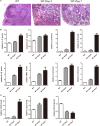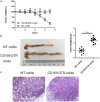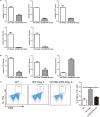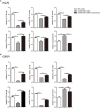CD169 Expressing Macrophage, a Key Subset in Mesenteric Lymph Nodes Promotes Mucosal Inflammation in Dextran Sulfate Sodium-Induced Colitis
- PMID: 28694804
- PMCID: PMC5483437
- DOI: 10.3389/fimmu.2017.00669
CD169 Expressing Macrophage, a Key Subset in Mesenteric Lymph Nodes Promotes Mucosal Inflammation in Dextran Sulfate Sodium-Induced Colitis
Abstract
Inflammatory bowel disease (IBD) including Crohn's disease (CD) and ulcerative colitis is a relapsing-remitting illness. Patients with long-standing extensive colitis are easy to develop colorectal cancer (CRC). The increasing incidence of IBD and a substantial increase in the risk of CRC make the necessity to pay more attention on the regulation of inflammation especially by specific macrophages subset. The present study reported that a key subset of sinus macrophage expressing CD169 in mesenteric lymph nodes (mLNs) played an essential role in promoting mucosal inflammation. The results revealed that the subset expressing CD169 in mLNs increased significantly during the dextran sulfate sodium (DSS)-induced colitis. The colitic symptoms were alleviated in CD169-diphtheria toxin receptor (DTR) mice at least partially due to the deletion of CD169+ macrophages in mLNs. In addition, the levels of inflammatory cytokines as well as the percentage of Th17 cells in mLNs from CD169-DTR mice were much lower than those from WT mice with DSS-induced colitis. Further experiment in vitro demonstrated that the supernatant from whole cells of mLNs or colon tissues could promote the production of inflammatory factors by mLN cells or colon tissues from CD169-DTR mice. These results could be explained by the cell sorting result that CD11b+CD169+ macrophages expressed higher level of inflammatory factors directly. All these data indicated that CD169+ sinus macrophage in mLNs played an essential role on regulating mucosal inflammation.
Keywords: CD169+ macrophages; colitis; cytokines; dextran sulfate sodium; mesenteric lymph nodes.
Figures







Similar articles
-
Macrophage Subset Expressing CD169 in Peritoneal Cavity-Regulated Mucosal Inflammation Together with Lower Levels of CCL22.Inflammation. 2017 Aug;40(4):1191-1203. doi: 10.1007/s10753-017-0562-0. Inflammation. 2017. PMID: 28466432
-
Low Dose of Cyanidin-3-O-Glucoside Alleviated Dextran Sulfate Sodium-Induced Colitis, Mediated by CD169+ Macrophage Pathway.Inflamm Bowel Dis. 2019 Aug 20;25(9):1510-1521. doi: 10.1093/ibd/izz090. Inflamm Bowel Dis. 2019. PMID: 31107535
-
Fermented barley and soybean (BS) mixture enhances intestinal barrier function in dextran sulfate sodium (DSS)-induced colitis mouse model.BMC Complement Altern Med. 2016 Dec 3;16(1):498. doi: 10.1186/s12906-016-1479-0. BMC Complement Altern Med. 2016. PMID: 27912750 Free PMC article.
-
Biodegradable microspheres targeting mucosal immune-regulating cells: new approach for treatment of inflammatory bowel disease.J Gastroenterol. 2003 Mar;38 Suppl 15:59-62. J Gastroenterol. 2003. PMID: 12698874 Review.
-
Functions of CD169 positive macrophages in human diseases (Review).Biomed Rep. 2021 Feb;14(2):26. doi: 10.3892/br.2020.1402. Epub 2020 Dec 17. Biomed Rep. 2021. PMID: 33408860 Free PMC article. Review.
Cited by
-
Deleterious effect of bone marrow-resident macrophages on hematopoietic stem cells in response to total body irradiation.Blood Adv. 2022 Mar 22;6(6):1766-1779. doi: 10.1182/bloodadvances.2021005983. Blood Adv. 2022. PMID: 35100346 Free PMC article.
-
Treatment of Dextran Sulfate Sodium-Induced Colitis with Mucosa-Associated Lymphoid Tissue Lymphoma Translocation 1 Inhibitor MI-2 Is Associated with Restoration of Gut Immune Function and the Microbiota.Infect Immun. 2018 Nov 20;86(12):e00091-18. doi: 10.1128/IAI.00091-18. Print 2018 Dec. Infect Immun. 2018. PMID: 30249750 Free PMC article.
-
Gegen Qinlian Decoction Alleviates Experimental Colitis and Concurrent Lung Inflammation by Inhibiting the Recruitment of Inflammatory Myeloid Cells and Restoring Microbial Balance.J Inflamm Res. 2022 Feb 24;15:1273-1291. doi: 10.2147/JIR.S352706. eCollection 2022. J Inflamm Res. 2022. PMID: 35237061 Free PMC article.
-
Exploring CD169+ Macrophages as Key Targets for Vaccination and Therapeutic Interventions.Vaccines (Basel). 2025 Mar 20;13(3):330. doi: 10.3390/vaccines13030330. Vaccines (Basel). 2025. PMID: 40266235 Free PMC article. Review.
-
CD169+ macrophage intrinsic IL-10 production regulates immune homeostasis during sepsis.Cell Rep. 2023 Mar 28;42(3):112171. doi: 10.1016/j.celrep.2023.112171. Epub 2023 Mar 2. Cell Rep. 2023. PMID: 36867536 Free PMC article.
References
LinkOut - more resources
Full Text Sources
Other Literature Sources
Molecular Biology Databases
Research Materials

